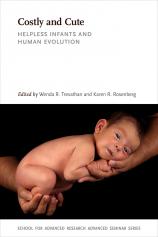Costly and Cute: Helpless Infants and Human Evolution
Review
Costly and Cute: Helpless Infants and Human Evolution
Human babies are more than just offspring. Unlike other animals and distinct from other primates, their birth comes with a price tag, and were they not adorable, they might not survive. These are among the many fascinating findings in these scholarly observations collected by Wenda R. Trevathan, Regents Professor emerita of anthropology at New Mexico State University, and Karen R. Rosenberg, professor of anthropology at the University of Delaware.
In the introductory chapter, "Human Evolution and the Helpless Infant," Trevathan and Rosenberg explain that there are two main species of mammals and birds: the altricial and the precocial. Altricial creatures (think "mice") are born after a short gestational period, in litters, with sealed eyes and ears, no hair, unable to locomote or feed themselves. Precocial creatures (think "horses") are born after a long gestational period, are mostly born one at a time, with open eyes and ears, can move or begin to imitate movement shortly after birth, have hair and can feed themselves almost immediately. Human babies have some altricial and some precocial characteristics, and they are also different from other primates in many ways. Compared to most primates, they are born with unhardened bones, undeveloped brains, limited movement and low immune function.
"Families planning to have a baby would do well to delve into COSTLY AND CUTE to learn significant terms and concepts..."
Not only that, but human infants require more energy ("cost") to produce: human pregnancy requires a high caloric intake, and babies and nursing mothers require yet more. And more calories are required to carry human infants (think "hunting and gathering" with a baby on your arm). But they repay their parents with their cuteness. Within hours of birth, they imitate locomotion by thrashing their limbs; they smile; as their vision develops, they look at the shiny things we offer them; and within a short time they recognize and react to familiar sounds, such as the repetition of their name. While these factors may seem trivial, the fact is they comprise a certain robustness or survivability that makes their parents want to keep them, cuddle them and train them. And that training, to be a human, has evolved over time based on highly varied, rich and increasingly complex cultures.
In the chapter "Baby the Trendsetter," Dean Falk states that unlike other primates, the human fetus spends its last trimester of gestation "eavesdropping" on its mother's speech patterns, a precursor to learning language sounds, phrasing, even grammar. E.A. Quinn, in "Infancy by Design," suggests that if human babies are more costly in terms of energy expenditure, boys are actually more expensive than girls since they weigh more. And with regard to "real" cost, the editors remind us that "in 2014, the average cost to raise a middle-income child to age eighteen approached a quarter of a million dollars."
The book arose out of an advanced seminar, "Costly and Cute --- How Helpless Newborns Made Us Human," held in 2014 at the School for Advanced Research in Santa Fe, New Mexico, chaired by the editors. Families planning to have a baby would do well to delve into COSTLY AND CUTE to learn significant terms and concepts, like alloparenting (child-rearing done by those other than the father and mother) and the importance, since time began, of the "mother-infant dyad" that proves the need for breastfeeding and co-sleeping, for every good reason.
Reviewed by Barbara Bamberger Scott on November 11, 2016
Costly and Cute: Helpless Infants and Human Evolution
- Publication Date: November 1, 2016
- Genres: Nonfiction, Social Sciences
- Paperback: 336 pages
- Publisher: University of New Mexico Press
- ISBN-10: 0826357458
- ISBN-13: 9780826357458



